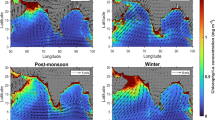Abstract
The marine sector surrounding Panarea Island (Aeolian Islands, South Italy) is affected by widespread submarine emissions of CO2 -rich gases and thermal water discharges which have been known since the Roman Age. On November 3rd, 2002 an anomalous degassing event affected the area, probably in response to a submarine explosion. The concentrations of minor reactive gases (CO, CH4 and H2) of samples collected in November and December, 2002 show drastic compositional changes when compared to previous samples collected from the same area in the 1980s. In particular the samples collected after the November 3rd phenomenon display relative increases in H2 and CO and a strong decrease in the CH4 contents, while other gas species show no significant change. The interaction of the original gas with seawater explains the variable contents of CO2, H2S, N2, Ar and He which characterize the different samples, but cannot explain the large variations of CO, CH4 and H2 which are instead compatible with changes in the redox, temperature and pressure conditions of the system. Two models, both implying an increasing input of magmatic fluids are compatible with the observed variations of minor reactive species. In the first one, the input of magmatic fluids drives the hydrothermal system towards atypical (more oxidizing) redox conditions, slowly pressurizing the system up to a critical state. In the second one, the hydrothermal system is flashed by the rising high-T volcanic fluid, suddenly released by a magmatic body at depth. The two models have different implications for volcanic surveillance and risk assessment: In the first case, the November 3rd event may represent both the culmination of a relatively slow process which caused the overpressurization of the hydrothermal system and the beginning of a new phase of quiescence. The possible evolution of the second model is unforeseeable because it is mainly related to the thermal, baric and compositional state of the deep magmatic system that is poorly known.
Similar content being viewed by others
Author information
Authors and Affiliations
Rights and permissions
About this article
Cite this article
Chiodini, G., Caliro, S., Caramanna, G. et al. Geochemistry of the Submarine Gaseous Emissions of Panarea (Aeolian Islands, Southern Italy): Magmatic vs. Hydrothermal Origin and Implications for Volcanic Surveillance. Pure appl. geophys. 163, 759–780 (2006). https://doi.org/10.1007/s00024-006-0037-y
Received:
Revised:
Accepted:
Published:
Issue Date:
DOI: https://doi.org/10.1007/s00024-006-0037-y




